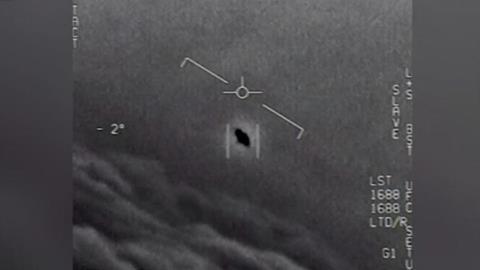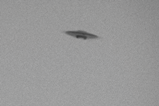Senior US government officials won’t investigate UFOs, because they’re “demonic”. That’s according to a counterintelligence officer, whose new book is shedding light on the Pentagon’s “most closely guarded secret”. Dr Matthew Halsted assesses the evidence

Every so often, our conception of reality gets turned upside down.
During the Copernican revolution human beings discovered the universe does not revolve around them. Even in the face of paradigm-shifting data such as this, our species has the ability to make the necessary epistemological adjustments and carry on with life. It is a virtue to be open to scientific discoveries, even the ones that stretch our imaginations.
Are we on the brink of yet another revolution? A passing glance at the news betrays a narrative that is rather suggestive in this regard - a narrative that feels repulsive to our common sense but no less interesting at the same time. I am talking about UFOs.
Mark Twain reportedly said, “The two most important days in your life are the day you are born and the day you find out why.” This quote, although likely apocryphal, is nonetheless true. But I might add that an equally important day would be the day we discover we are not alone in the universe. Such a discovery would certainly expand the horizons of our self-understanding.
Nothing human can make a 90-degree turn at 3,000 miles an hour and survive
But would the proven existence of life elsewhere in the universe pose a threat to the Christian faith, as many fear? Not at all. I agree with other scholars and theologians who believe no core doctrine would be undermined. The discovery of life beyond this planet would not threaten the truth of Christianity. It could even be an opportunity for the Church to glory in the fact that the choir which praises the creator is much larger than any of us had imagined (Psalm 19:1-2).
Religious people, then, should not be allergic to the UFO topic. In fact, the topic of religion has actually been, in some ways, at the driving center of the modern UFO narrative - a topic lurking, I am told, through the most secretive layers of the Pentagon.
A secret program
It all began with an extraordinary and riveting New York Times article in 2017 which uncovered “The Pentagon’s Mysterious U.F.O. Program.” The official name is the Advanced Aerospace Threat Identification Program (AATIP), which was led by Luis “Lue” Elizondo, a counterintelligence officer who was tapped to investigate the phenomena of UAPs (Unidentified Anomalous Phenomena). Elizondo grew frustrated with a lack of transparency and eventually resigned in order to “protest” the “excessive secrecy and internal opposition” he was experiencing. Today, he (along with many of his colleagues) is a public advocate for disclosure. His new book, Imminent: Inside the Pentagon’s hunt for UFOs (John Blake), was published yesterday, and claims to offer “a first-hand, revelatory account inside the Pentagon’s most closely guarded secret.”
Part of the “internal opposition” to investigating UAPs came on the basis of religious concerns. According to Elizondo, “senior government officials,” thought the phenomenon represented a “threat to their belief system.” They knew it was real, but they concluded it to be “demonic in nature.” Though Elizondo disagrees, he doesn’t take it personally. In fact, he applauds these same officials, calling them “some of the most incredibly competent and loyal patriots I have ever had the privilege to work with, and their motivations were sincere.”
I recently spoke with Elizondo, and he relayed to me that there were indeed “several individuals in the Pentagon who objected for spiritual reasons.” And this is not just Elizondo’s claim. Former Senate Majority Leader, the late Harry Reid, went on the record saying that some of the pushback was due to the “religious views” by key intelligence officials at the Pentagon.
The demon hypothesis
As a theology professor, I’ve long been captivated by this aspect of the story. Religious concerns (specifically, the demon hypothesis) have increasingly made their way into the core part of the UFO narrative - not just, allegedly, at the Pentagon, but also in the public. For example, former astronaut Charlie Duke (the 10th man to walk on the moon) says UAPs are “real,” but they are “demonic beings.” He adds that, “Nothing human can make a 90-degree turn at 3,000 miles an hour and survive.” The purpose behind showing off their extraordinary capabilities is “to draw [people] away from the real God.” Tucker Carlson recently made similar claims.
I asked Elizondo whether these intelligence officials presented any evidence for their demon hypothesis. The answer was no. “There was no real logic,” he said. “I did not understand why they did not want to look at the data further.” And for Elizondo, that’s the rub. The idea that this could just be swept aside on the basis of religious assumptions was flabbergasting. But he tries to understand the other side’s point nonetheless. This was clear from the question he asked me: “If you thought God told you this was demonic, wouldn’t you be afraid?” Elizondo admits that everyone needs to be open to the various hypotheses, including the spiritual ones. “Maybe they’re right - maybe it is demonic,” he said. “But either way, we need to investigate further to find out.”
Extraordinary claims
After the 2017 New York Times article, the US Congress began passing legislation to formally look into the matter. The first major law created provisions for whistleblowers to disclose to Congress what they knew about “material retrieval, material analysis, [and] reverse engineering” of UAPs. Soon thereafter, an Air Force intelligence officer named David Grusch came forward with claims that, quite frankly, rival a Spielberg film. As an employee of the National Geospatial-Intelligence Agency, Grusch was asked to serve on the government’s UAP Task Force. In his investigations, Grusch told Congress under oath that he found evidence of a “multi-decade UAP crash retrieval and reverse engineering program” that had been illegally siloed away from proper congressional oversight. He says the US is in possession of not just non-human craft, but also non-human bodies.
At one point, Grusch filed a complaint with the Intelligence Community Inspector General (ICIG) because he began to experience threats and pushback. After looking into the matter, the ICIG sent a report to Congress, saying Grusch’s claims were “credible and urgent.”
Now, just because Grusch testified under oath before Congress, does not make his story true. People lie under oath all the time. People also misinterpret data. Is this a fair assessment of David Grusch? Recent actions by the Senate Majority Leader, Chuck Schumer, reveal that the situation is far more complex.
Together with Senator Mike Rounds, Schumer proposed last year an aggressive piece of legislation. It was called “The UAP Disclosure Act,” which Schumer said is needed because, “The American public has a right to learn about technologies of unknown origins, non-human intelligence, and unexplainable phenomena.” The proposal was not successful. However Schumer and Rounds are undeterred. Just last month they re-introduced their amendment, which seeks answers about government programs that may exist that “collect, exploit, or reverse engineer technologies of unknown origin or examine biological evidence of living or deceased non-human intelligence.”
Neither Schumer nor Rounds are political lightweights, so what would lead them to enquire about something so exotic? The justification, they write, is based on “credible evidence and testimony” that relevant UAP “records” exist. Are they simply wanting to track down dusty classified files? Hardly. Astonishingly, the amendment includes an “eminent domain” provision that seeks to retrieve “any and all recovered technologies of unknown origin and biological evidence of non-human intelligence that may be controlled by private persons or entities in the interests of the public good.”
To make matters even more interesting, they add further that this “Legislation is necessary to restore proper oversight over unidentified anomalous phenomena records by elected officials in both the executive and legislative branches of the Federal Government that has otherwise been lacking.” In other words, they believe that Congress and the President have been kept out of the loop of information. These are extraordinary claims. And they assume the core of Grusch’s allegations.
The myth of reality
For many, the UAP narrative smells of superstition - a lore of stories baked in delusion and irrationality. And yet, at the same time, there’s enough compelling data to lead one into reluctant admission that there may indeed be more to this strange story than meets the eye. This fact alone causes a lot of angst. Its strangeness lends to uneasiness, not least for Christians.
The discovery of the real often starts within the realm of the myth
Arguably, this dialectical nexus between the strangeness of the subject on the one hand and the credibility the story has acquired on the other has created an environment in which a sinister interpretation (such as the “demon hypothesis”) can gain viable traction among people of faith. There’s more than enough credible data to pique interest, but just enough abstruseness to create shadows of doubt. And, as we know, monsters tend to come alive in the dark.
James Newman writes a fascinating account in this regard. Prior to the early 1900s, rumors swirled of a terrifying creature that haunted the jungles of Africa. The hearsay included fanciful tales of how these humanoid monsters could make fire, build huts to live in, slay elephants, and routinely kidnap women. But as investigations increased over time, only then would the chaff separate from the wheat. What emerged from the mythos was, for Westerners, a new discovery: the gorilla. Many facets of the rumors proved to be unfounded (gorillas don’t actually build huts, nor do they steal women). And yet, there was still truth wedged within the myth. And, in fact, it was through the myth that human curiosity piqued and truth was finally discovered. Newman puts it well: “The discovery of the real often starts within the realm of the myth.”
When all one has are rumors and stories, imaginations can’t help but spawn mythic monsters of overemphasized proportions. Angst inevitably ensues. But just as fear can live in the dark, so can truth live in a cacophony of myth. Is there truth, then, to be found in the UAP story? Or is it all troubling hearsay? There were no elephant-slaying monsters in Africa, but there was indeed something behind the tales - a discovery made only after thorough scientific investigation. That’s how truth often emerges. And that is Elizondo’s point. “Copernicus caused angst,” he told me. “But the truth ultimately came out.”
The pressing question at this time is not merely whether any of this is true, but whether one is currently justified in believing it is so. Given the current state of the public evidence, it seems to me that there are two extremes to avoid - namely, foolish naivety on the one hand and bullish skepticism on the other. Gullibility isn’t a virtue (Proverbs 14:15); neither is it wise to think our frail minds have the cosmos figured out (Job 38-41). The universe is vast, and God’s creative abilities even more so.
As it stands today, what one can say with confidence, perhaps, is that UAPs represent something that dwells in the land of myth - the same place, mind you, where real gorillas have been known to roam.




































7 Readers' comments